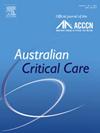Understanding crisis needs among family caregivers of patients in critical care: A qualitative analysis
IF 2.6
3区 医学
Q2 CRITICAL CARE MEDICINE
引用次数: 0
Abstract
Background
Family caregivers often experience shock and disorientation when a patient is admitted to critical care. Developing interventions to assist caregivers during this crisis requires a more in-depth understanding of their needs.
Objective
Our aim was to understand family caregivers' needs during a patient's critical care admission and early hospitalisation and differences in needs by caregiver anxiety level.
Methods
We conducted a descriptive mixed-method study. Forty semistructured interviews were conducted with family caregivers of mechanically ventilated critical care patients. The Hospital Anxiety and Depression Scale was also administered. Crisis theory was used to guide this analysis. The data were analysed by content analysis and then stratified by anxiety level to examine differences across groups. Consolidated Criteria for Reporting Qualitative Research were followed.
Setting
Two intensive care units at a large, tertiary academic medical centre were a part of this study.
Findings
Caregivers at all anxiety levels described needs involving information and emotional processing, social support, and self-care, with differences across anxiety groups. Caregivers with anxiety and borderline anxiety expressed limited capacity to think past the current moment, whilst caregivers with low anxiety actively used information to consider next steps and prepare others. Emotional processing appeared more limited in the anxiety and borderline-anxiety groups. Whilst most caregivers reported receiving some degree of social support, some caregivers with anxiety noted family tension, whilst caregivers with borderline and low anxiety had a wider variety of supportive relationships. Caregivers with anxiety reported distress influenced their self-care, whilst caregivers with borderline and low anxiety received tangible help from other family members for self-care.
Conclusion
Family caregivers of critical care patients experience needs during early hospitalisation, although the specific needs differ by caregiver anxiety level.
了解危重病人家属照顾者的危机需求:一项定性分析
当病人被送进重症监护室时,家庭护理人员经常会感到震惊和迷失方向。在这场危机中制定干预措施以帮助护理人员,需要更深入地了解他们的需求。我们的目的是了解患者在重症监护入院和早期住院期间的家庭照顾者需求,以及照顾者焦虑水平对需求的影响。方法采用描述性混合方法研究。对机械通气危重病人的家庭护理人员进行了40次半结构化访谈。同时进行医院焦虑抑郁量表。危机理论被用来指导这一分析。通过内容分析对数据进行分析,然后根据焦虑水平进行分层,以检查各组之间的差异。采用了报告定性研究的综合标准。在一个大型三级学术医疗中心的两个重症监护室是本研究的一部分。发现所有焦虑水平的照顾者描述的需求涉及信息和情绪处理、社会支持和自我照顾,在焦虑组之间存在差异。焦虑和边缘性焦虑的照顾者表达了有限的能力来思考过去的时刻,而低焦虑的照顾者积极利用信息来考虑下一步并为他人做好准备。焦虑组和边缘焦虑组的情绪处理似乎更有限。虽然大多数照顾者报告得到一定程度的社会支持,但一些焦虑的照顾者注意到家庭紧张,而边缘和低焦虑的照顾者则有更广泛的支持关系。焦虑的照顾者报告说,痛苦影响了他们的自我照顾,而边缘和低焦虑的照顾者则从其他家庭成员那里得到了切实的自我照顾帮助。结论危重病人的家庭照顾者在住院早期有需求,但具体需求随照顾者焦虑程度的不同而不同。
本文章由计算机程序翻译,如有差异,请以英文原文为准。
求助全文
约1分钟内获得全文
求助全文
来源期刊

Australian Critical Care
NURSING-NURSING
CiteScore
4.90
自引率
9.10%
发文量
148
审稿时长
>12 weeks
期刊介绍:
Australian Critical Care is the official journal of the Australian College of Critical Care Nurses (ACCCN). It is a bi-monthly peer-reviewed journal, providing clinically relevant research, reviews and articles of interest to the critical care community. Australian Critical Care publishes peer-reviewed scholarly papers that report research findings, research-based reviews, discussion papers and commentaries which are of interest to an international readership of critical care practitioners, educators, administrators and researchers. Interprofessional articles are welcomed.
 求助内容:
求助内容: 应助结果提醒方式:
应助结果提醒方式:


